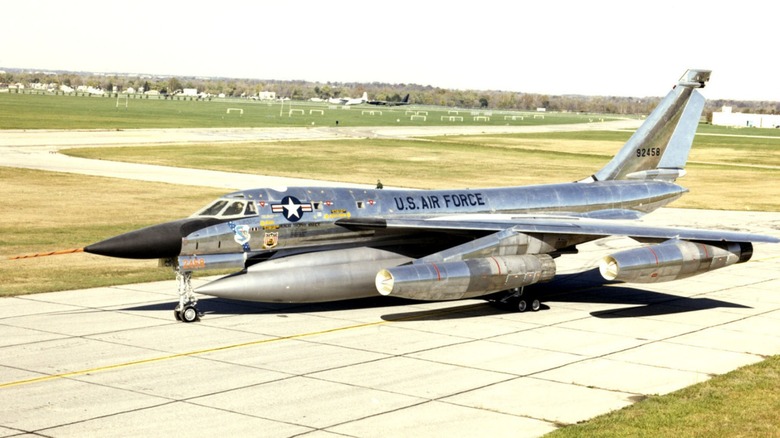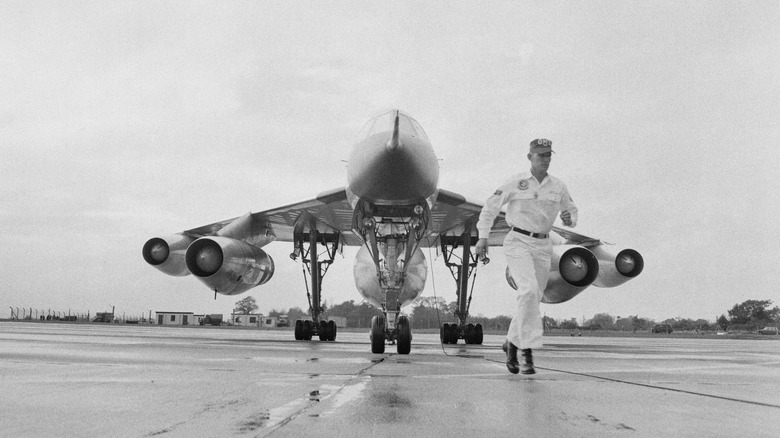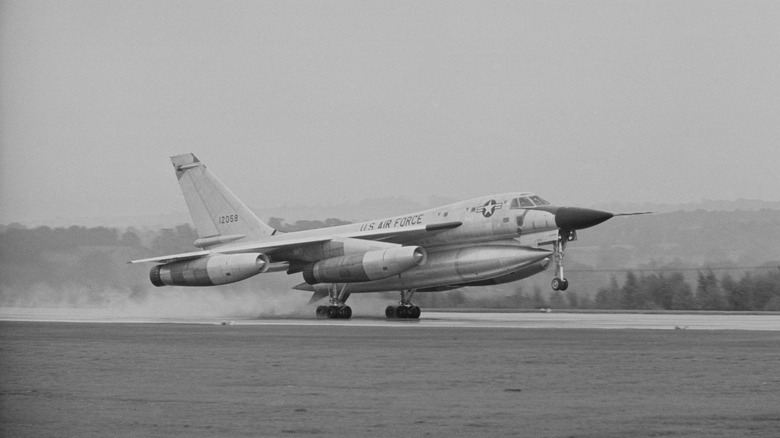The High-Speed Strategic Bomber That Pushed The Limits Of Supersonic Aviation
When thinking of the immense array of bombers that the U.S. Air Force wields these days, it's easy to picture powerful weapons of war that are adept at both delivering enormous explosive payloads and avoiding interception. The Department of Defense has worked tirelessly to incorporate anti-detection coatings and fuselage designs in modern aircraft, as well as faster speed and greater maneuverability. All of these next-gen enhancements are built around the core goal of achieving aerial dominance at a moment's notice.
But the progenitor of much of the technological superiority that U.S. jets incorporate today stem directly from monumental breakthroughs of the previous era. One of the most stunning examples of historical excellence in the skies is the Convair B-58 Hustler.
Launched for the first time on November 11, 1956, the B-58 Hustler quickly made a name for itself and transformed what the Air Force and pilots thought was possible in the skies above. The bomber was designed for extreme high altitude flying and added an effective combat range of 2,500 miles to Air Force capabilities.
Hustlers were delivered to Kelly Air Force Base in March 1960, and in addition to their utility as a combat-ready bomber, entered service as a ground maintenance training tool at Kelly. The bomber sported a wingspan of nearly 57 feet and a nose to tail length of about 97 feet. All of these features made the jet a sight to behold, but it was the sonic boom that really caught an onlooker's attention.
Height and speed were crucial elements of the jet's flight capability
Unveiled in 1956, the B-58 Hustler was in service for the U.S. Air Force between 1960 and 1970. Convair built 116 jets in total, with 86 going into operation, and 30 built as pre-production and test aircraft. The Hustler was capable of reaching speeds of 1,325 miles per hour, and could achieve a total range of 4,400 miles without refueling. Hustlers could also achieve an altitude ceiling of just under 65,000 feet. While it's possible for commercial jets to reach great heights, the majority of travel that ticketholders cruise along for is done at an altitude of roughly half this feat (35,000 feet, typically).
Height and speed make aircraft difficult to detect and harder to intercept. For comparison, the F-22 Raptor is rated for an altitude limit of 60,000 feet (with some models offering extended range up to 65,000 feet), but can achieve a top pace of 1,500 miles per hour. Fighter jets are sleeker and often incorporate better maneuverability for faster travel. This means that a bomber either must fly with a defensive accompaniment, or achieve a higher flight path than the enemy can functionally defend against.
In it's time, the B-58 Hustler broke 19 world speed and altitude records, making it both one of the fastest and highest-flying aircraft in the skies.
The B-58 was designed to carry nuclear payloads
Perhaps the feature of the B-58 Hustler that most inspired fear in 1960s-era adversaries wasn't the technical proficiency of the jet, but rather it's intended weapons platform. The B-58 Hustler was built to be crewed by a team of three, and it's payload design was built to house nuclear warheads.
Convair built the bomber as a scant piece of machinery. Everything about the jet was designed to accomplish a singular goal: securely transporting a nuclear weapon from mission launch to a hostile target, and then accurately unleashing it. As a result, the aircraft includes no internal weapons compartments and makes use of just a single two-component weapons pod beneath the body of the aircraft itself. For in-air defense, the jet includes a single 20mm cannon mounted in the rear.
Inside the pod, the mission control teams could load extra fuel, reconnaissance equipment, and nuclear bombs to be dropped in only the most dire circumstances. It was and remains imperative that the U.S. military can both store and deploy these devastating weapons as a matter of deterrence, given the post-Cold War landscape of nuclear armaments around the globe. The Convair B-58 Hustler does just that, and with its potent blend of supersonic travel capability and armaments, it advanced the very concept of what's achievable in the realm of human flight.


